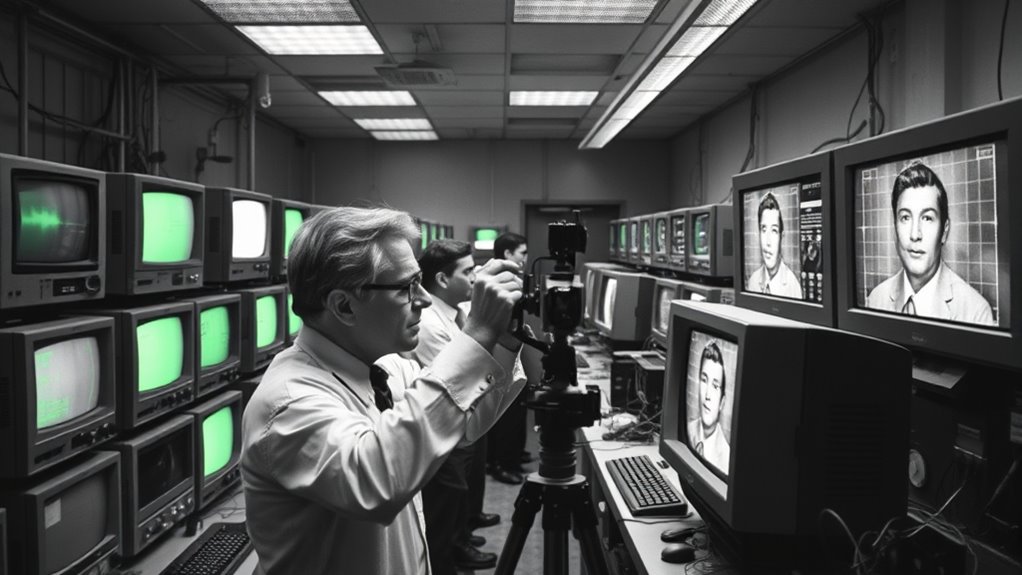The first wave of facial recognition teaches you that simple algorithms, based on limited facial measurements, struggle with real-world variability and scale poorly without diverse, high-quality data. Ethical concerns and privacy issues are crucial considerations that shaped responsible development. Understanding these early lessons reveals why modern systems focus on data diversity, robustness, and ethics. If you want to explore how these foundational lessons influence today’s technology, there’s much more to uncover.
Key Takeaways
- Early face recognition relied on simple measurements, which were insufficient for handling variability in real-world conditions.
- Limited and homogeneous datasets caused biases and inaccuracies, highlighting the importance of diverse, high-quality data.
- Systems performed well in controlled environments but struggled under real-world lighting, angles, and expressions.
- Privacy concerns and ethical implications were often overlooked, underscoring the need for responsible development and use.
- Incorporating statistical models and robust testing early on laid the foundation for more accurate and fair facial recognition technology.

Have you ever wondered how facial recognition technology can identify you in seconds? It’s impressive how quickly this technology works, but understanding its origins reveals important lessons that still matter today. The first wave of facial recognition development was driven by the desire to improve security and streamline identification processes. Early efforts focused on creating algorithms capable of matching facial features from images, often relying on simple measurements like distances between eyes or the shape of the jawline. These initial systems were limited, often struggling with variations in lighting, angles, or facial expressions, but they laid the groundwork for future innovations.
One key lesson from this early phase is that simplicity isn’t enough for complex tasks. Developers initially thought that basic measurements could suffice, but they soon learned that faces are highly variable. This realization pushed researchers to develop more sophisticated methods, such as analyzing the geometry of facial features and later incorporating statistical models. The *bridge* from rudimentary techniques to more advanced algorithms taught us that a deeper understanding of the problem leads to better solutions. It’s a reminder that in technology, as in life, oversimplifying can hinder progress.
Simplifying complex tasks can hinder progress; understanding the problem leads to better solutions.
Another lesson is the importance of vast, diverse data sets. Early facial recognition systems trained on limited, often homogeneous images, which made them prone to errors and biases. This experience underscored the necessity of using diverse data to create more accurate and fair systems. When you’re designing or using facial recognition today, it’s *imperative* to remember that the quality and diversity of data directly impact performance and fairness. Ignoring this can lead to misidentifications and ethical issues, which continue to challenge the technology’s deployment.
The first wave also highlighted the importance of testing in real-world conditions. Many early systems performed well in controlled environments but faltered in everyday situations. This taught developers that robustness and adaptability are *indispensable*. For you, as a user or developer, it’s a lesson in always testing technology where it will be used, not just in ideal conditions. It’s a reminder that the best systems are those that can handle variability and unexpected challenges.
Additionally, understanding the role of color accuracy in image quality was crucial even in early systems, as it affected how well facial features could be distinguished under different lighting conditions. Finally, the initial efforts in facial recognition taught us about privacy and ethics. Early implementations often overlooked the implications of mass surveillance and data collection. As a result, public concern grew, prompting discussions about responsible use. The lesson is clear: technological progress must be balanced with ethical considerations. Moving forward, understanding this balance is *imperative* to ensure that facial recognition benefits society without infringing on individual rights. These lessons from the first wave remain relevant today, guiding responsible innovation in facial recognition technology.
Frequently Asked Questions
How Has Facial Recognition Technology Evolved Since Its First Wave?
Since its first wave, facial recognition technology has evolved considerably. You now benefit from advanced algorithms that improve accuracy and speed, even in challenging conditions. Deep learning models enable systems to better distinguish individuals, reducing false matches. Additionally, integration with other biometric data enhances security. Overall, these advancements make facial recognition more reliable, versatile, and easier to implement across various applications like security, smartphones, and law enforcement.
What Ethical Considerations Emerged During the Initial Development of Face Recognition?
During the initial development of face recognition, you should consider privacy concerns, as people worry about being constantly monitored without consent. Bias and accuracy issues also emerged, raising questions about fairness across different demographics. You need to recognize potential misuse, like surveillance or discrimination, which can harm individual rights. These ethical considerations prompt you to develop guidelines ensuring transparency, accountability, and responsible use to protect citizens’ privacy and rights.
Which Industries Adopted Face Recognition Technology Earliest and Why?
You might find it astonishing, but law enforcement agencies were among the earliest adopters of face recognition technology, keen to harness its unparalleled ability to identify suspects in real-time. Security firms and airports quickly followed, captivated by its potential to revolutionize safety. These industries adopted it early because they believed it could dramatically enhance security, streamline operations, and grant them an almost superhuman edge in crime prevention and surveillance efforts.
What Were the Main Technical Challenges Faced During the First Wave?
During the first wave of face recognition, you faced challenges like limited accuracy due to poor image quality and variations in lighting or angles. Computing power was also a hurdle, making real-time processing difficult. Additionally, you struggled with developing robust algorithms that could distinguish between individuals reliably. Data privacy concerns and the need for large, diverse datasets further complicated progress, slowing down widespread adoption and refinement of the technology.
How Did Public Perception Influence Early Face Recognition Deployment?
Imagine a mirror reflecting your deepest fears—that’s how public perception shaped early face recognition. You might have felt uneasy, watched as privacy concerns cast long shadows over its deployment. Society’s skepticism and outrage acted like stormy clouds, delaying progress and demanding stricter controls. Your concern for privacy and fairness became a catalyst, pushing developers and policymakers to rethink and refine the technology, aiming for trust and transparency in its use.
Conclusion
Just as Icarus learned, overshooting boundaries can lead to downfall, so too with face recognition’s first wave. By heeding these lessons, you avoid the pitfalls of hubris and embrace responsible innovation. Remember, every great story—like Prometheus stealing fire—teaches us that power comes with responsibility. Stay grounded, learn from the past, and wield this technology wisely. The future’s path depends on what you choose to carry forward from these early lessons.








